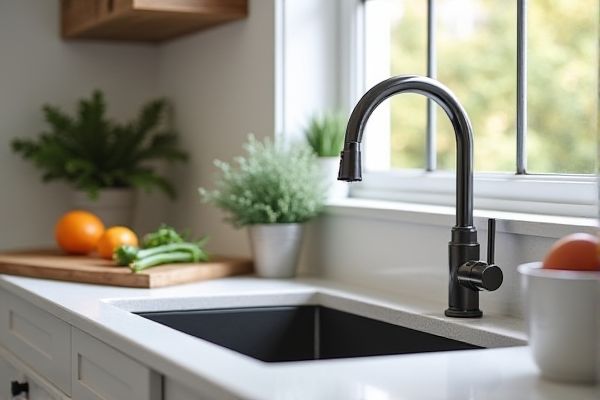
Pot fillers offer the convenience of filling large pots directly on the stovetop, reducing the need to carry heavy water containers across the kitchen, while standard faucets provide a versatile solution for general kitchen tasks. Discover how choosing the right faucet can enhance your kitchen efficiency and convenience by reading the rest of the article.
Table of Comparison
| Feature | Pot Filler | Standard Faucet |
|---|---|---|
| Location | Mounted above the stove or countertop | Mounted on the sink |
| Purpose | Fills pots directly on the stove | General use for washing dishes, hands, and produce |
| Installation Complexity | Requires additional plumbing and wall mounting | Standard sink installation, less complex |
| Water Flow | Lower flow rate, designed for filling pots | Variable flow rates for multiple uses |
| Design | Articulating arm with swivel joints | Single or double handle with fixed spout |
| Convenience | Eliminates carrying heavy pots to sink | Essential for general kitchen tasks |
| Cost | Higher cost due to specialized function and installation | Generally more affordable and common |
Pot Filler vs Standard Faucet: Key Differences
Pot fillers are wall-mounted faucets designed for filling large pots directly on the stove, offering convenience and saving counter space compared to standard faucets typically installed over sinks. Standard faucets provide versatile use for various kitchen tasks, while pot fillers specialize in targeted water delivery close to cooking areas, reducing the need to carry heavy pots filled with water across the kitchen. Choosing between a pot filler and a standard faucet depends on your cooking habits and kitchen layout, with pot fillers enhancing efficiency in kitchens frequently used for large meal preparations.
Design and Installation Overview
Pot fillers feature an articulated arm design that extends from the wall above the stove, offering flexibility for filling large pots without lifting. Standard faucets typically mount on the sink deck, featuring a fixed or single-handle design focused on general kitchen use. Installation of pot fillers requires wall reinforcement and plumbing near the cooking area, whereas standard faucets install directly into sink or countertop holes with conventional water supply connections.
Space and Placement Considerations
Pot fillers offer significant space-saving benefits by mounting directly above the stove, eliminating the need to carry heavy pots filled with water from the sink to the cooktop. Standard faucets are typically installed at the sink, requiring ample countertop space and frequent movement across the kitchen. Your kitchen layout should prioritize pot fillers in compact areas where counter space is limited, while standard faucets suit larger, more open designs where flexibility in usage is essential.
Water Flow and Reach Comparison
Pot fillers typically offer higher water flow rates, often between 2.2 and 2.5 gallons per minute, compared to standard faucets that average around 1.5 to 2.2 gallons per minute, enabling faster filling of large pots. The extendable arm design of pot fillers provides superior reach, commonly extending up to 24 inches from the wall, whereas standard faucets have a fixed spout reach averaging 8 to 12 inches above the sink. This enhanced reach and flow capacity make pot fillers ideal for cooking tasks that require filling heavy cookware directly on the stove.
Convenience and Accessibility
Pot fillers offer unmatched convenience by allowing you to fill large pots directly on the stove, eliminating the need to carry heavy containers from the sink. Standard faucets require you to transport pots, which can be cumbersome and increase the risk of spills. Your kitchen workflow becomes more efficient with a pot filler, enhancing accessibility and reducing strain during cooking.
Aesthetic Appeal in Kitchen Design
Pot fillers offer a sleek, modern aesthetic that enhances kitchen design by providing a specialized, streamlined look often favored in contemporary and high-end kitchens. Unlike standard faucets, which are typically installed at the sink and can appear bulky or utilitarian, pot fillers are wall-mounted and create a minimalist visual impact. Their unique placement above the stove not only saves counter space but also serves as a striking design element that complements upscale kitchen aesthetics.
Maintenance and Cleaning Requirements
Pot fillers require occasional cleaning to prevent mineral buildup due to their wall-mounted position near the stove, which can expose them to cooking splatters and grease. Standard faucets, typically located at the sink, are easier to clean regularly due to better accessibility and may require less frequent deep maintenance. Both types benefit from routine descaling and lubrication of moving parts to ensure longevity and smooth operation.
Cost and Budget Analysis
Pot fillers generally cost between $150 and $400, making them a more expensive option compared to standard faucets, which typically range from $50 to $150. Installation costs for pot fillers can be higher due to their specialized placement and the need for additional plumbing work, potentially increasing your overall budget. Choosing between the two depends on your kitchen setup and whether the convenience of a pot filler justifies the upfront and installation expenses.
Safety and Potential Issues
Pot fillers reduce the risk of lifting heavy pots filled with water, minimizing strain and potential spills in the kitchen compared to standard faucets. Standard faucets may cause water splashing or burns due to limited reach, while pot fillers, installed near the stove, offer precise control and safer filling of large cookware. However, pot fillers require careful installation to avoid leaks and must be regularly maintained to prevent water damage and mold growth in surrounding cabinetry.
Which Faucet Type Suits Your Kitchen?
Pot fillers offer convenience by allowing you to fill large pots directly on the stove, reducing the need to carry heavy containers across your kitchen. Standard faucets provide versatility and are typically more cost-effective, making them a practical choice for everyday washing and cleaning tasks. Your decision should consider kitchen layout and cooking habits to determine which faucet type best enhances your efficiency.
 homyna.com
homyna.com